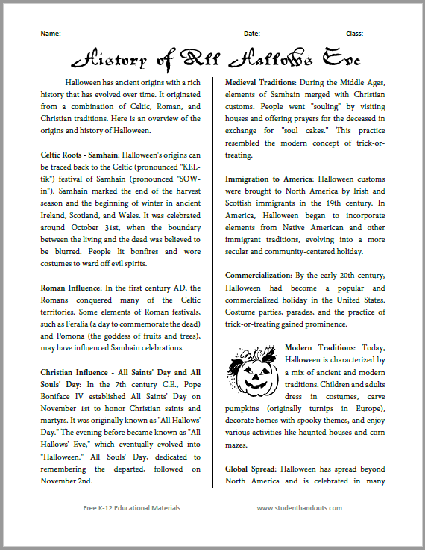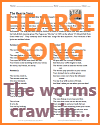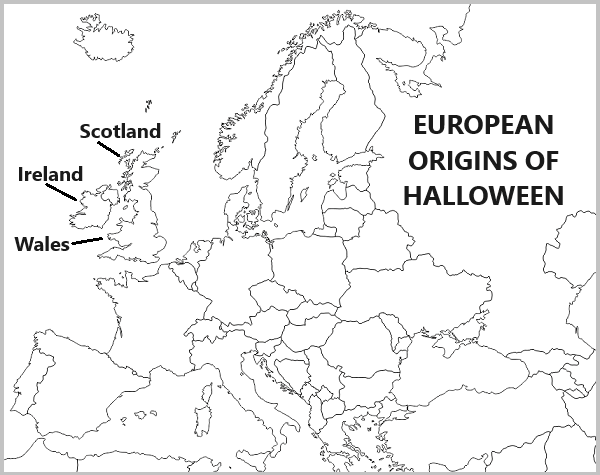| History of All Hallows' Eve Printable Worksheet |
|---|
| www.studenthandouts.com ↣ Fun Stuff ↣ Holiday Games & Worksheets ↣ Halloween |
 |
    |
|
Click here to print. Answer Key: (1) when the boundary between the living and the dead was believed to be blurred; (2) All Hallows' Day; (3) visiting houses and offering prayers for the deceased in exchange for "soul cakes"; (4) c - 1800s; (5) see map below. Halloween has ancient origins with a rich history that has evolved over time. It originated from a combination of Celtic, Roman, and Christian traditions. Here is an overview of the origins and history of Halloween. Celtic Roots - Samhain: Halloween's origins can be traced back to the Celtic (pronounced "KEL-tik") festival of Samhain (pronounced "SOW-in"). Samhain marked the end of the harvest season and the beginning of winter in ancient Ireland, Scotland, and Wales. It was celebrated around October 31st, when the boundary between the living and the dead was believed to be blurred. People lit bonfires and wore costumes to ward off evil spirits.  Roman Influence: In the first century A.D., the Romans conquered many of the Celtic territories. Some elements of Roman festivals, such as Feralia (a day to commemorate the dead) and Pomona (the goddess of fruits and trees), may have influenced Samhain celebrations.
Roman Influence: In the first century A.D., the Romans conquered many of the Celtic territories. Some elements of Roman festivals, such as Feralia (a day to commemorate the dead) and Pomona (the goddess of fruits and trees), may have influenced Samhain celebrations.Christian Influence - All Saints' Day and All Souls' Day: In the 7th century C.E., Pope Boniface IV established All Saints' Day on November 1st to honor Christian saints and martyrs. It was originally known as "All Hallows' Day." The evening before became known as "All Hallows' Eve," which eventually evolved into "Halloween." All Souls' Day, dedicated to remembering the departed, followed on November 2nd. Medieval Traditions: During the Middle Ages, elements of Samhain merged with Christian customs. People went "souling" by visiting houses and offering prayers for the deceased in exchange for "soul cakes." This practice resembled the modern concept of trick-or-treating. Immigration to America: Halloween customs were brought to North America by Irish and Scottish immigrants in the 19th century. In America, Halloween began to incorporate elements from Native American and other immigrant traditions, evolving into a more secular and community-centered holiday. commercialization: By the early 20th century, Halloween had become a popular and commercialized holiday in the United States. Costume parties, parades, and the practice of trick-or-treating gained prominence. Modern Traditions: Today, Halloween is characterized by a mix of ancient and modern traditions. Children and adults dress in costumes, carve pumpkins (originally turnips in Europe), decorate homes with spooky themes, and enjoy various activities like haunted houses and corn mazes. Global Spread: Halloween has spread beyond North America and is celebrated in many countries worldwide, although the customs and traditions may vary. Some countries, like Mexico, celebrate Día de los Muertos (Day of the Dead) around the same time as Halloween, focusing on honoring deceased loved ones. Contemporary Themes: Halloween has also incorporated contemporary themes from popular culture, including costumes inspired by movies, television, and popular culture. Cultural and Religious Significance: While Halloween has largely become a secular and commercial holiday, some religious groups, particularly in the United States, choose not to celebrate it due to its historical associations with the supernatural and the dead. Today, Halloween is a holiday celebrated for fun, creativity, and community. It retains elements of its ancient Celtic, Roman, and Christian roots, while continually evolving to reflect the cultural and societal changes of the times. It has become a time for dressing up, indulging in treats, and enjoying festivities with family and friends. |
| www.studenthandouts.com ↣ Fun Stuff ↣ Holiday Games & Worksheets ↣ Halloween |








